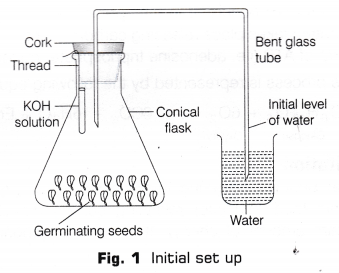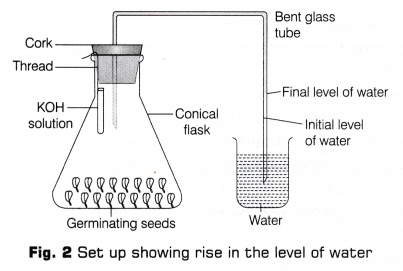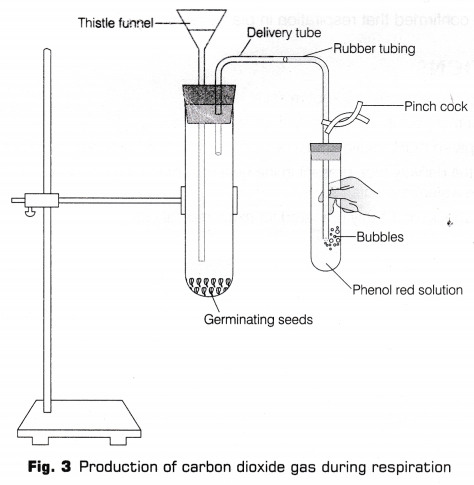CBSE Class 10 Science Lab Manual – CO2 is Released During Respiration
Aim
To show that carbon dioxide is released during the process of respiration.
Theory/Principle
Plants perform many physiologically important functions to survive like photosynthesis and respiration. Respiration is a catabolic process (as large molecules are broken down into smaller units) and may be defined as the process that liberates energy when organic molecules are oxidised.
Respiration is of two types:
- Aerobic
- Anaerobic
1. Aerobic Respiration
It is the respiration process occurring in the presence of oxygen. A complete oxidation of glucose (carbohydrates) takes place releasing carbon dioxide gas, water and a large amount of energy in the form of ATP (i.e. adenosine triphosphate) during this process.
The reaction of this process is represented by the following equation:

2. Anaerobic Respiration
It is the respiration process occurring in the absence of oxygen. It leads to incomplete oxidation of organic food (glucose) releasing carbon dioxide and ethyl alcohol and a very less/insignificant amount of energy. It is more commonly called as fermentation in micro-organisms.
The reaction of this process is represented by the following equation:

In this experiment to show that CO2 is released during respiration, moist gram seeds are used as they are actively respiring and release CO2.
The released CO2 is absorbed by KOH and forms K2CO3 (Method 1).

Also, CO2 can cause lime water to change its appearance (Method 2).
METHOD 1
Materials Required
A conical flask, soaked and germinating seeds of gram, 20% freshly prepared KOH (potassium hydroxide) solution, vaseline, U-shaped delivery tube (a tube bent twice at right angles), moist cloth (cotton/wool or moist blotting paper), water, thread, beaker, test tube and a rubber cork with one hole.
Procedure
- Take about 30-40 seeds of gram soaked in water and allow them to germinate by placing them on a moist cotton/wool or blotting paper or moist cloth for 2-5 days.
- Transfer the germinating seeds (seeds with a whitish outgrowth) into a conical flask and add few drops of water to keep the seeds moist.
- Take the freshly prepared solution of 20% KOH in a test tube and suspend it in the conical flask using a thread just above the germinating seeds.
- The mouth of the conical flask is closed by placing the rubber cork with one hole. Ensure that the thread tied to KOH containing tube is firmly placed and held at a correct distance.
- Take the U-shaped delivery tube, insert one of its end in the conical flask through the hole in the rubber cork. The other end of the delivery tube is placed in a beaker containing water.
- Seal all the connections of the experimental set up (Fig. 1) with vaseline (petroleum jelly) to make the apparatus airtight.

- Mark the initial level of water in the delivery tube and leave the set up undisturbed for 1-2 hours.
- Observe the change in the level of water in the delivery tube immersed in water inside the beaker.
Observation
After 2 hours, it was observed that the level of the water has risen up in the U-shaped delivery tube dipped in the beaker from the initial marked level (Fig. 2).
Germinating seeds in the conical flask release CO2 during respiration which is absorbed by KOH kept in small tube. Due to the absorption of CO2 a vacuum is created in the flask which causes the rise in level of water in the delivery tube.
Another method can also be used to show that CO2 releases during respiration by plants.

METHOD 2
Materials Required
Germinating gram seeds, lime water or phenol red indicator, vaseline, a thistle funnel, a delivery tube, a rubber tubing, rubber cork with two holes, conical flask and a boiling tube.
Procedure
- Place about twenty germinating seeds in a boiling tube containing some water in it.
- Fit a two-bore rubber cork to the mouth of the boiling tube. Make the set up air-tight by applying a thin smear of petroleum jelly so that the gas evolved during the process of respiration by the germinating seeds does not leak out.

- Fix a thistle funnel through one of the bores in the cork. The lower end of thistle funnel must dip in water.
- Pass a delivery tube through the second bore of the cork, Attach a rubber tubing to the delivery tube, fold it backwards and fix a pinch cock. Using a clamp, fix the boiling tube to a stand as shown in Fig. 3.
- Place the set up in bright sunlight for about one hour.
- Takeaboutl mLof water in a test tube (1 drop of water has a volume of nearly 0.1 ml).Add two drops of phenol red indicator to it and shake. Note the colour.
- Dip the free end of rubber tubing into the test tube containing phenol red indicator solution and release the pinch cock.
- Pour a few mL of water through the thistle funnel into the boiling tube containing germinating gram seeds.
- Observe bubbles of a gas emerging from the rubber tube dipped in the phenol red indicator solution. Shake the test tube vigorously and note the change in the colour of indicator. Record your observations.
Observation
The colour of phenol red indicator changes from pink (in neutral/alkaline medium) to pale yellow (in acidic medium) due to the addition of carbon dioxide in it.
Result
The germinating seeds of gram performs active respiration and release C02 which can be – seen as:
- The increased level of water in the U-shaped delivery tube in method 1
- Colour change of’ phenol red from pink colour to pale yellow in method 2.
Thus, it is confirmed that respiration in plants releases CO2.
Precautions
Germinating seeds should be kept moist at all times.
All the experiment setup connections must be air tight.
Freshly prepared KOH solution must be used. KOH is corrosive, handle it carefully
The end of the delivery tube present in the beaker In both methods should be completely immersed in water/lime water.
Lime water should be freshly prepared for experimental use.
Viva – Voce
Question 1.
What is the roie of KOH in this experiment (Method 1)? [NCERT]
Answer:
The KOH solution suspended in the flask absorbs the CO2 released by germinating seeds.
Question 2.
When we say that plants and animals respire, where exactly is the process occurring? [NCERT]
Answer:
The process of respiration occurs in the mitochondria of the cell.
Question 3.
Why do we use germinating seeds in this experiment (Method 1)? [NCERT]
Answer:
Germinating seeds respires actively at a faster rate.
Question 4.
Why germinating seeds or flower buds are ideal materials for this experiment (Method 2)? [NCERT]
Answer:
Because their cells are active and they actively exchange the respiratory gases (CO2 and O2) as the oxidation of food takes place in these cells.
Question 5.
Why is the experimental setup kept in sunlight in method 2? [NCERT]
Answer:
To make the rate of germination much faster.
Question 6.
Why do we pour water into the boiling tube containing germinating seeds through a thistle funnel? [NCERT]
Answer:
Thistle funnels are used to add small amount of liquids (water) to an exact position. Thus, water is poured through a thistle funnel into the boiling tube containing germinating seeds as water is required for germination.
Question 7.
What is the gas that reacts with phenol red indicator (or with the lime water)? [NCERT]
Answer:
CO2
Question 8.
How do germinating seeds respire—aerobically or anaerobically? Analyse. [NCERT]
Answer:
Germination seeds respire aerobically. CO2 is produced as an end product, when respiration occurs in the presence of oxygen.
Question 9.
Drop a NaOH (or KOH) pellet into the pale yellow phenol red indicator and observe? Reason out the cause of the change. [NCERT]
Answer:
Pale yellow phenol red indicator (acidic medium) will turn into pink on addition with NaOH or KOH. As phenol red gives pink colour on addition of base.
Question 10.
In which form energy is produced and utilised in our body?
Answer:
ATP (Adenosine triphosphate).
Question 11.
The germinating seeds are required to be kept moist during the experiment. Why so?
Answer:
Germinating seeds are in growing stage and require water. If water is not available, the seeds will dry up and rate of respiration will slow down.
Question 12.
Aerobic respiration is different from anaerobic respiration. How?
Answer:
| Aerobic respiration | Anaerobic respiration | |
| (i) | Occurs in the presence of O2. | Occurs in the absence of O2. |
| (ii) | CO2 and energy are produced. | Alcohol or acid depending upon the site is produced. |
| (iii) | High yield of energy. | Very low or insignificant energy yield. |
| (iv) | Complete oxidation of molecules. | Incomplete oxidation occurs. |
Question 13.
Does respiration occur in plants only at a specific time?
Answer:
No, plants perform respiration at all the times.
Question 14.
Why is respiration called a catabolic process?
Answer:
As in this process, larger molecules are broken down into smaller units with release of energy.
Science Lab ManualScience Practical SkillsScience LabsMath LabsMath Labs with Activity